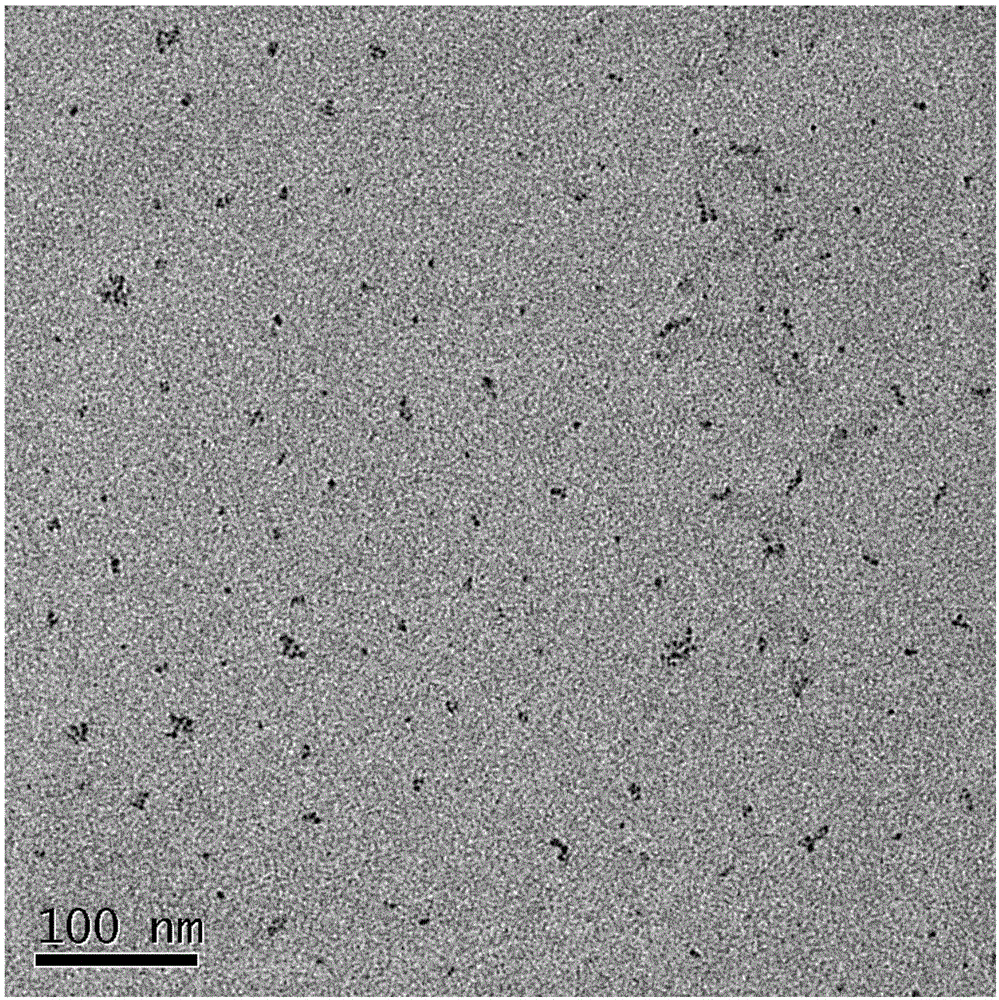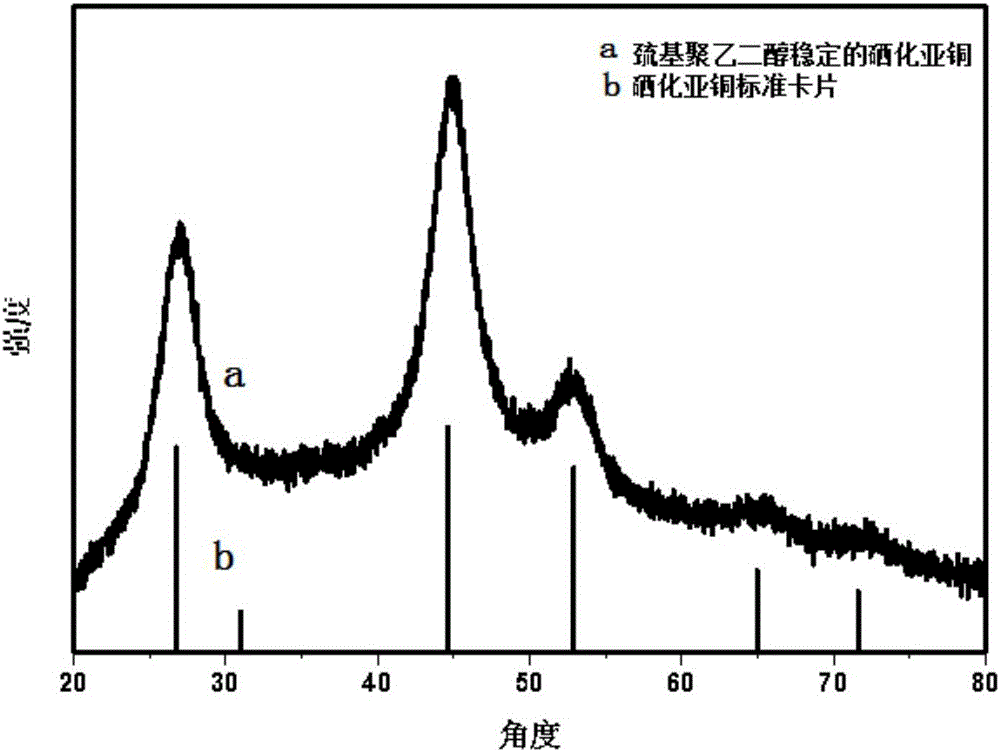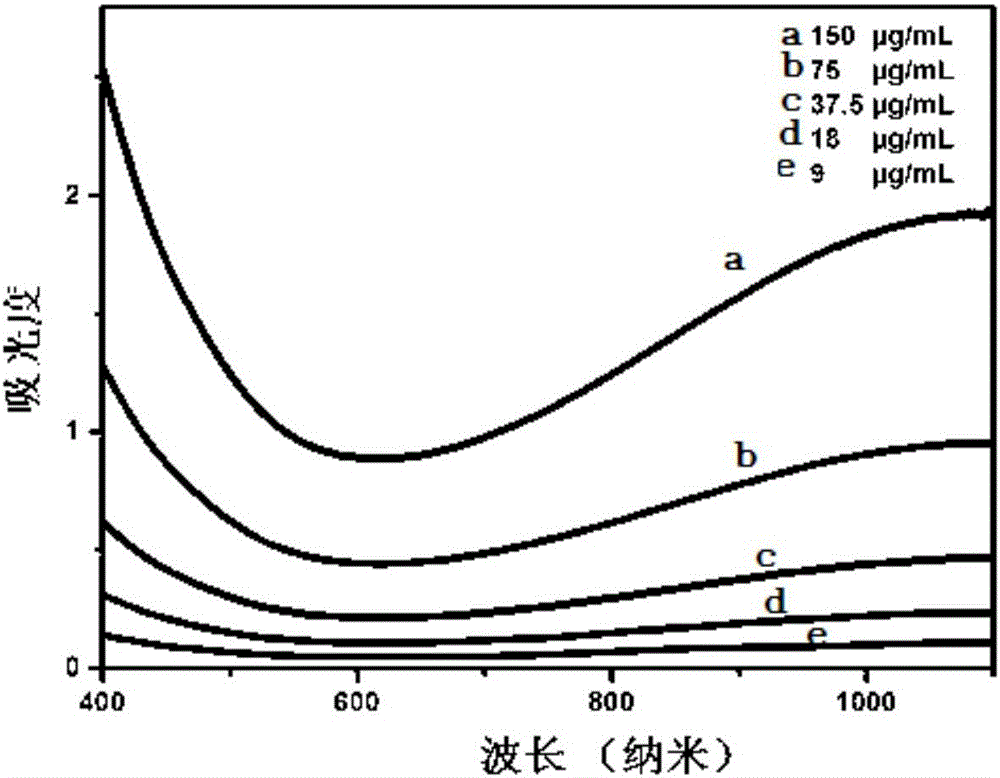Preparation method and application of metal sulfur-group compound multifunctional nano probe
A nano-probe and compound technology, applied in the fields of material chemistry and biomedicine, can solve the problems of ultra-small cuprous selenide nanoparticles that have not been reported, and achieve broad market application prospects and mild preparation methods
- Summary
- Abstract
- Description
- Claims
- Application Information
AI Technical Summary
Problems solved by technology
Method used
Image
Examples
Embodiment 1
[0046] Disperse 0.5 mmol of selenium powder in 50 mL of deionized water, add 1.5 mmol of sodium borohydride powder into the selenium powder dispersion system under the protection of an inert gas, mix well, and reduce the selenium powder to colorless. 1 g of mercaptosuccinic acid and 0.17 g of copper chloride dihydrate powder were dissolved in 5 mL of water, and then added to the above-mentioned selenium precursor solution, and stirred and reacted at room temperature for 1 hour. After the reaction is finished, the solution is subjected to multiple ultrafiltration separations to obtain cuprous selenide nanoparticles stabilized by mercaptosuccinic acid.
[0047] The cuprous selenide sample stabilized by mercaptosuccinic acid was redispersed in about 30mL of aqueous solution, and 0.2g of bismercaptopolyethylene glycol (molecular weight: 5000) was added. After stirring and reacting at room temperature for 6 hours, the solution was separated by ultrafiltration several times. After d...
Embodiment 2
[0053] Disperse 0.5mmol of selenium powder in 50mL of deionized water, and pass through inert gas protection. Add 1.5 mmol of sodium borohydride powder into the selenium powder dispersion system, mix well, and reduce the selenium powder to colorless. 1 g of polyvinylpyrrolidone (PVP-K30) and 0.17 g of copper chloride dihydrate powder were dissolved in 5 mL of water, and then added to the above-mentioned selenium precursor solution, and stirred for 1 hour at room temperature. After the reaction is finished, the solution is subjected to multiple ultrafiltration separations to obtain a polyvinylpyrrolidone-stabilized cuprous selenide sample.
[0054] attached Figure 7 X-ray diffraction pattern of cuprous selenide nanoparticles stabilized by polyvinylpyrrolidone. attached Figure 8 It is the UV absorption pattern of cuprous selenide nanoparticles stabilized by water-soluble polyvinylpyrrolidone. attached Figure 9 It is a transmission electron micrograph of cuprous selenide ...
Embodiment 3
[0056] Disperse 0.5mmol of selenium powder in 50mL of deionized water, and pass through inert gas protection. Add 1.5 mmol of sodium borohydride powder into the selenium powder dispersion system, mix well, and reduce the selenium powder to colorless. 1 g of mercaptosuccinic acid and 0.17 g of silver nitrate powder were dissolved in 5 mL of water, then added to the above-mentioned selenium precursor solution, and stirred and reacted at room temperature for 1 hour. After the reaction is finished, the solution is separated by ultrafiltration several times to obtain a silver selenide sample stabilized by mercaptosuccinic acid.
[0057] attached Figure 10 X-ray diffraction pattern of silver selenide nanoparticles stabilized with mercaptosuccinic acid. attached Figure 11 UV absorption pattern of silver selenide nanoparticles stabilized by water-soluble mercaptosuccinic acid. attached Figure 12 It is a transmission electron micrograph of silver selenide nanoparticles.
PUM
| Property | Measurement | Unit |
|---|---|---|
| size | aaaaa | aaaaa |
Abstract
Description
Claims
Application Information
 Login to View More
Login to View More - R&D
- Intellectual Property
- Life Sciences
- Materials
- Tech Scout
- Unparalleled Data Quality
- Higher Quality Content
- 60% Fewer Hallucinations
Browse by: Latest US Patents, China's latest patents, Technical Efficacy Thesaurus, Application Domain, Technology Topic, Popular Technical Reports.
© 2025 PatSnap. All rights reserved.Legal|Privacy policy|Modern Slavery Act Transparency Statement|Sitemap|About US| Contact US: help@patsnap.com



